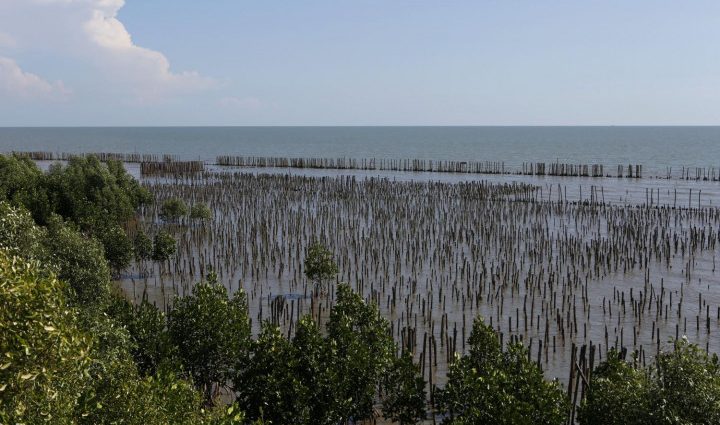
The idea of building a new city out of filling sea areas of about 300,000 rai, from Samut Prakan’s tambon Pak Nam of Muang district to the mouth of Tha Chin River in Samut Sakhon, is gaining momentum, with some experts backing the idea.
The proposed land reclamation project will also double as a key mechanism for preventing Bangkok from being submerged by floodwater, while curbing the worsening coastal erosion in Bangkok’s Bang Khunthian district, situated between Samut Prakan and Samut Sakhon.
The landfill idea was floated by former prime minister Thaksin Shinawatra during his high-profile dinner talk, Vision for Thailand 2024, held in Bangkok on Aug 22, in which he listed the proposal as one of the government’s future development plans.
Urgent need
Suchatvee Suwansawat is among those welcoming the idea, saying it should have been implemented long ago.
“It’s a good sign that such an important figure in the country sees this as an important matter,” he said. The land reclamation proposal has brought fresh hope to people working to save Bangkok from flooding and other problems associated with coastal erosion.
Mr Suchatvee, a civil engineering expert, is a former president of King Mongkut’s Institute of Technology Ladkrabang and chair of the Engineering Institute of Thailand. He now is a deputy leader of the Democrat Party.
The work to improve the economy is the government’s top priority, while the fight to protect Bangkok from a worsening flood situation is also important and deserves to be recognised as a priority as well, he said.
“Global warming and how it exacerbates flooding is something everyone should have paid sufficient attention to long ago,” he said. “Not only engineers but the public should be well aware of the impact of global warming.”
Technically, filling Bang Khunthian’s eroded coastal areas and the surrounding seas is possible and will potentially add more liveable land to this district whose space has been dwindling due to serious coastal erosion situation, said Mr Suchatvee.
The city couldn’t wait for the gradual natural process of sediments being deposited, which could result from a previous proposal to build groynes perpendicular to the shoreline of Bang Khunthian’s coast. That would never keep up with the speed of coastal erosion, he said.
“The prime minister and the Bangkok governor should treat this reclamation idea seriously because it should have been adopted for implementation long ago. More than 2 kilometres of coastal land have been eroded already,” he said.
The idea was proposed to City Hall a long time ago, he said, but he had heard nothing since.
Bamboo sticks have been adopted as a material used in building breakwaters even though they aren’t solid enough for this purpose, he said. This bamboo normally becomes sea waste in one to two years after being put in.
The Metropolitan Electricity Authority had previously donated concrete power posts to the BMA for use to build breakwaters as well, but these posts still weren’t an ideal solution either even though they are more solid than bamboo, he said. Neither was growing more mangroves, he said.
In addition to the coastal erosion problem, sea intrusion has become a serious problem to certain parts of Bangkok, including Bang Kholaem, Silom, Sathon and Phra Nakhon, he said.
Households in these areas sometimes find their tap water tasting rather brackish and that is the evidence of the sea intrusion problem, he said.
Lessons from Singapore
Asst Prof Thon Thamrongnawasawat, deputy dean of the Faculty of Fisheries at Kasetsart University, also backed the reclamation idea. He said if the environment could be protected, the plan could work out.
Singapore has adopted such a model and is planning to build a new long island to stretch in parallel to a road leading to its airport, named Long Beach, said Asst Prof Thon, a marine environment expert.
“However, it can’t be implemented completely even in five or 10 years because a substantial budget and really strong commitment are needed,” he said.
If Bangkok was to adopt the same model as Singapore’s, a budget for funding the inclusion of an effective environmental protection system must be secured.
Even though the cost of adding an environment protection system to the project may increase total costs by 3-10%, the system is necessary, he said.
If the project is implemented without a crucial environment protection system, new problems will arise; marine creatures normally inhabiting the seashore areas will die out.
“The key question is, will the government be committed to investing that much to make it happen?” he said. “Normally, when the budget is limited in such a project, the part of the budget for funding environment protection is the first to be slashed.”
The BMA previously said it was speeding up a project to build a sea dyke to protect Bang Khunthian’s 47km coast from further erosion, after more than 2,700 rai of coastal land were lost to erosion. The project is undergoing an environmental impact assessment.

